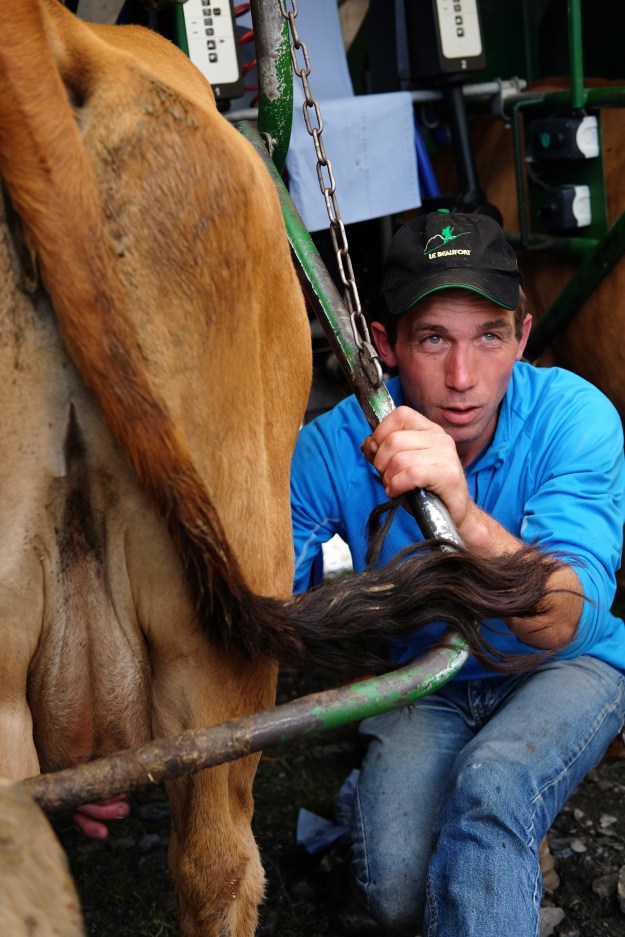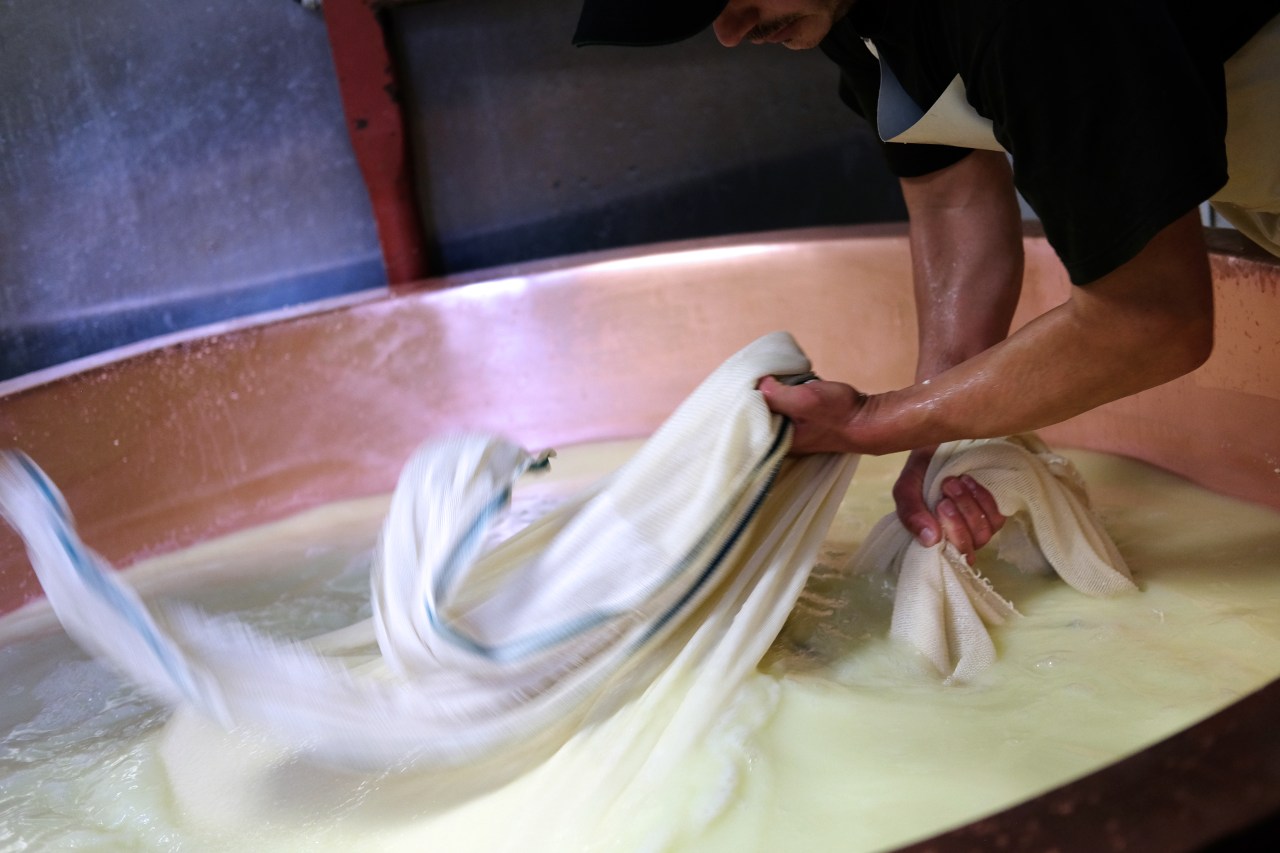“Have you ever seen anything like this?” Rémy Perret asks me, raising his voice over the melody of a hundred cowbells. His piercing blue eyes are smiling with pride and probably judging me a tiny bit for the Parisian that I am. This gorgeous piece of land, high up in the Alps, is where he has worked his entire life. Not bad for an office.
We’re at an altitude of 5,500 feet in Méribel-Mottaret, part of Les Trois Vallées, the world’s largest skiable area. Some might even call it the best, thanks to its spectacular panoramas and an elaborate network of resorts, restaurants, lifts, and ski runs. Like many locals, Perret works as a ski teacher in the winters. But today the ground is a bright shade of pale green. It’s summer. And in the summer, here, we make cheese.
Encircled by his 156 cows, Perret’s brother Raphaël explains how the milking machine works. Cows enter the eight stations from one side, the shepherd Yannick Empereur adjusts the pumps on the cows, and they’re out the other side a few minutes later. It takes a little over two hours to milk the entire herd, which is done twice a day. Every two days the cows move to another part of the valley, and the machine follows.
I make way for a (loud, determined) cow and take in the scenery. The air is crisp but warm, and the mountain’s flanks glow in the sunlight. No, I have never seen anything like this.

Look at a map of the region of Auvergne-Rhône-Alpes and you might feel like you’re reading the bottom line of a French menu: Saint-Marcellin, Saint-Félicien, Beaufort … This is cheese country. In fact, I was brought here by Enzo Richon, a young cheesemonger who works at the Fromagerie Les Alpages in the nearby city of Grenoble. When I asked Richon to tell me about a cheese called Beaufort Chalet d’Alpage, he offered to show me instead. That’s how I met the Perret family.
Beaufort Chalet d’Alpage is a type of Beaufort that’s tastier and rarer than the other two (straight-up Beaufort and Beaufort d’été). But it’s also much more difficult to make: It must be entirely produced at a minimum altitude of 1,500 meters (4,921 feet), which is only possible around 100 days of the year when the snow has melted. The milk should come from only one herd, though two types of cows are accepted, and it must be transformed immediately after they’re milked. Finally, French regulations mandate that this regional specialty can only be made in a certain geographical zone. All of these requirements explain why today there are only about a dozen farmers who make Beaufort Chalet d’Alpage.
The Perret family’s operations take place in a small farm overlooking Lake Tuéda, where groups of tourists stop for sandwiches before a hike. It’s been a few years since the three brothers, Rémy, Raphaël, and Cédric, took over from their parents; but during the summer, Robert and Odile Perret, now retired, like to stay here to keep an eye on things. Not that they need to, but they enjoy spending time up at the farm with their kids and grandkids.
“The first time I came up to an alpage [a high pasture where cows graze], I was 12,” says Rémy. It was 1989, and his father had just left the pastoral collective he was managing to start his own business. “At the time we had 140 goats and 70 cows; that’s all we could house. And I would be running behind the goats a lot because they weren’t tied up, so the whole valley you see in front of you, everywhere around here, I know it all by heart.”


France‘s dairy farmers have been in the news since the European Union dropped the cap on milk production in 2015, bringing the price below what many organizations deem sustainable, let alone profitable. Farms have gone out of business, younger generations are looking to make a living elsewhere, and the rate of depression and even suicide is growing among farmers.
Some, like the Perret family, have been spared from the crisis thanks to the nature of the products they make. Last year the Perrets produced and sold 700 wheels of Beaufort Chalet d’Alpage. “We never have any left over,” Rémy and Raphaël tell me, speaking over each other. In a way, the rigid regulations have protected the few producers of cheeses like Beaufort Chalet d’Alpage, ensuring a healthy ratio of supply and demand. “We get a certain number of wheels per year,” explains Richon, whose fromagerie sells Beaufort Chalet d’Alpage for $19.27 per pound. “We would love to buy more, but we can’t—there just isn’t any more.”
I spot the shiny milk canister on the back of a pickup truck, wobbling down the mountain road. In two and a half hours this milk will already be cheese, though it takes at least eight months of aging to become dense and flavorful. In the stuffy workroom, Nicolas Harasémiuc pours it, still warm, in large copper vats before curdling it at a temperature of 33 degrees Celsius (91.4 degrees Fahrenheit). Then he breaks it up expertly into small chunks with a 16-stringed tool and turns up the heat to 54 C (129 F). Now comes the tricky part: Armed with a linen cloth, he wedges his feet below the vat and balances the top half of his body horizontally to pick up the liquid. The linen acts as a filter: Whey pours out of the massive bundle, which is then squeezed into a concave wooden mold.



“Our cheese is made the old-school way,” Rémy explains, rubbing his hand on the large wheels stacked in the cellar next door. “We make it all by hand, and so each wheel is different.” Because Beaufort Chalet d’Alpage demands a highly specific set of skills—the simple act of flipping over a 90-pound wheel requires strength and strategy—employees are hard to come by. Harasémiuc, a shy young man from Romania, has been working for the Perret family for the past six years. He hardly knew how to speak French or make cheese when he arrived, but today he’s part of the family, Raphaël says. “When you want to keep your employees, just like in any job, you treat them well. Especially because it’s becoming harder and harder to find people.”
All of the Perret family’s employees are housed and fed in the summer: Yannick Empereur, the shepherd, has a house up in the alpage, while Harasémiuc and Jean-Luc André live at the farm. Harasémiuc is the only one who works for the family year-round, spending the quieter winter months with his wife in an apartment nearby. The rest of the time she’s back home in Romania, where they are building a house for the family with the money earned here.
As the sun starts to set behind the mountains, André takes the remaining content of the vat outside. Nothing is wasted; there is still enough whey to make a cheese called sérac. Rémy Perret and André grab a skimmer each and silently fill the plastic pots placed on a large table. The day is nearly over, and there’s something ethereal about this quiet final step. Suddenly a large bang echoes from inside the processing room: the last flip of the day. Tomorrow the Beaufort Chalet d’Alpage will be moved into the cellar and wait until 2019 to be sold and eaten.